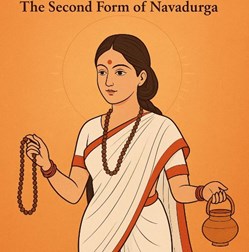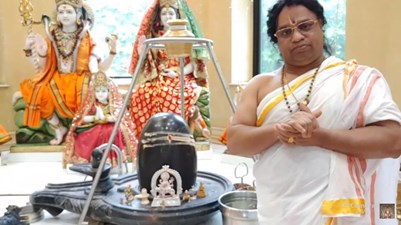Goddess Brahmacharini – The Second Form of Navadurga

Goddess Brahmacharini – The Second Form of Navadurga
Worship Date in 2025:23rd September 2025 (Tuesday)
Significance & Benefits
Worshipping Brahmacharini on Day 2 of Navratri brings:
- Enhanced focus and spiritual growth
- Strength to endure hardships with grace
- Blessings for wisdom and inner peace
- Relief from Mars-related astrological imbalances
- Chant: Om Devi Brahmacharinyai Namah
- Offer: Sugar, fruits, sandalwood, and flowers
- Rituals: Lighting a ghee lamp, reciting Durga Saptashati, and meditating on her form
- Wear: White attire to reflect purity and devotion
Planetary Connection
She governs Mars, influencing determination, discipline, and spiritual energy.
Introduction to Goddess Brahmacharini -The second form of Goddess Durga
Goddess Brahmacharini is the second form of Goddess Durga and one of the nine aspects of Navadurga. She is worshipped on the second day of Dwitiya, October 04, 2024, a Friday of Navratri, the nine-day festival of the Goddess. The word Brahmacharini means "one who practices austerity" or "one who follows the path of Brahman". She represents the stage of life when Goddess Parvati performed severe penance to attain Lord Shiva as her husband. She is also the symbol of wisdom, knowledge, devotion, and purity.
Origin of Brahmacharini Mata
The origin of Goddess Brahmacharini is related to the story of Goddess Parvati's birth and rebirth. According to Hindu mythology, Goddess Parvati was born as Sati, the daughter of Daksha Prajapati, a powerful king and a son of Brahma. Sati deeply loved Lord Shiva and married him against her father's wishes. However, Daksha insulted Shiva and Sati in a grand sacrifice (yajna) that he organised. Unable to bear the humiliation, Sati immolated herself in the sacrificial fire.
Sati was reborn as Parvati, the daughter of Himavan, the king of the mountains, and Mena, his wife. Parvati grew up with a desire to marry Lord Shiva, who was still mourning for Sati. She performed rigorous penance (tapas) to please and win his heart. Parvati renounced all worldly comforts and pleasures and lived like an ascetic in the Himalayas. She ate only fruits and leaves and later subsisted on air alone. Parvati endured harsh weather conditions and wild animals. She meditated on Lord Shiva's name and form for thousands of years.
During this period, she came to be known as Brahmacharini, the one who followed the path of Brahman or the supreme reality. She also earned the blessings of many gods and sages who admired her devotion and determination.
The Iconography of Goddess Brahmacharini
Goddess Brahmacharini is depicted as a beautiful young woman with a fair complexion and a radiant aura. She wears a simple white saree with a red border. She has two arms and holds a rosary (japa mala) in her right hand and a water pot (kamandalu) in her left hand. She has long black hair tied in a bun or a braid. She wears a rudraksha necklace and earrings. She has a calm and serene expression on her face.
The rosary represents her devotion to Lord Shiva and her practice of meditation. The water pot represents her simplicity and detachment from worldly pleasures. The white colour represents her purity and innocence. The red colour represents her passion and love for Lord Shiva.
The Worship of Goddess Brahmacharini- 2nd day of Navratri
Goddess Brahmacharini is worshipped on the second day (Dwitiya) of the bright fortnight (shukla paksha) of the month of Ashwin (September-October), which coincides with the second day of Navratri. On October 4, 2024, Friday, devotees wake up early in the morning and take a bath. They wear clean clothes and pray to Lord Ganesha, Goddess Durga, and Maa Brahmacharini. They also offer flowers, incense, lamps, fruits, sweets, coconut, betel leaves, kumkum, sandalwood paste, etc., to the Goddess.
The central ritual of worshipping Maa Brahmacharini involves performing a puja or homa with sesame seeds (til). Sesame seeds are considered sacred and auspicious for this day as they symbolise prosperity and abundance. Devotees also chant mantras, hymns, and shlokas dedicated to Goddess Brahmacharini. They also listen to stories or legends related to her life and deeds.
Some devotees also observe a fast on this day to show their respect and devotion to Goddess Brahmacharini. They abstain from eating grains, salt, alcohol, meat, onions, garlic, and other similar foods. They only consume fruits, milk, water, or other light food items.
The Legends of Brahmacharini Mata
Many legends associated with Brahmacharini Mata illustrate her power and glory. Here are some of them:
- One legend says that when Goddess Parvati performed penance in the Himalayas, she was attacked by a demon named Prakandasura, who wanted to marry her by force. He came with an army of millions of demons and surrounded her. Goddess Parvati was helpless as she was in the last stage of her penance and could not fight back. She prayed to Lord Shiva for protection. Meanwhile, the gods and sages also came to her rescue and fought with the demons.
- Another legend says that when Goddess Parvati was performing penance in the Himalayas, she was visited by Lord Shiva in disguise as a Brahmin (a priest). He came to test her devotion and love for him. The Brahmin started to criticize Lord Shiva and his qualities. He said that Lord Shiva was a poor, dirty, uncivilized, and ignorant ascetic who lived in cremation grounds and wore snakes and skulls as ornament and added that Lord Shiva was unfit for Goddess Parvati who was a princess and a goddess.
- A third legend says that when Goddess Parvati performed penance in the Himalayas, she was visited by Lord Brahma, the creator of the universe. He came to bless her and grant her a boon. He asked her what she wanted from him. Goddess Parvati said that she wanted to marry Lord Shiva and nothing else. Lord Brahma said that he could not grant her this boon as it was against the destiny of Lord Shiva, who had vowed to remain celibate after the death of Sati. He said only Lord Shiva could change his destiny and marry her if he wished. Brahma advised her to continue her penance and impress Lord Shiva with her devotion and determination. He also gave her a mantra to chant that would help her achieve her goal. The mantra was "Om Namah Shivaya," which means "I bow to Lord Shiva."
Planet controlled by Maa Brahmacharini
The planet controlled by Goddess Brahmacharini is Mars (Mangal). Mars is the planet of energy, action, courage, passion, aggression, competition, ambition, initiative, leadership, willpower, strength, bravery, etc. Mars also represents blood, fire, weapons, accidents, injuries, wars, conflicts, enemies, etc.
Mars is the son of Goddess Earth (Prithvi) and Lord Fire (Agni). He is also known as Bhauma (the son of Earth), Kuja (the one who is born from fire), Angaraka (the one who is red like fire), etc. He rides a chariot drawn by eight red horses and carries a spear (shakti), a mace (gada), a sword (khadga), and a shield (khetaka) as his weapons. Mars wears red clothes and jewels.
Mars is associated with Goddess Brahmacharini because they both are related to tapas or austerity. Goddess Brahmacharini performed severe penance to attain Lord Shiva as her husband. Mars also represents the power of tapas or self-discipline that can help one achieve one's goals. Mars also represents the courage and determination that Goddess Brahmacharini showed in facing various obstacles and challenges in her path.
The Significance of Goddess Brahmacharini
Goddess Brahmacharini is significant for many reasons. She is the symbol of wisdom and knowledge. Brahmacharini attained the supreme knowledge of Brahman or the ultimate reality through her penance. The Goddess also taught this knowledge to others who sought her guidance. She is also associated with Saraswati, the goddess of learning.
Goddess Brahmacharini represents the life of Goddess Parvati, who, as a devoted ascetic, performed severe penance to attain Lord Shiva as her husband. Brahmacharini is also the goddess of devotion, knowledge, wisdom, and willpower. She is associated with the Swadhisthana Chakra and the planet Mars.
The mantras of Goddess Brahmacharini
- Om Devi Brahmacharinyai Namah: This is the seed mantra that invokes the goddess and offers salutations to her.
- Dadhanaa kara padmabhyam akshamala kamandalaha Devi praseedatu mayi Brahmacharini anuttama: This is a hymn that praises the goddess for holding a rosary and a water pot in her lotus-like hands and asks for her blessings.
- Ya Devi Sarvabhuteshu Maa Brahmacharini Rupena Samsthita Namastasyai Namastasyai Namastasyai Namo Namah: This is another hymn that acknowledges the presence of the goddess in all beings as Brahmacharini and offers repeated salutations to her.
The prayers of Goddess Brahmacharini
Prayers to Goddess Brahmacharini are usually done on the second day of Navratri by offering flowers, rice, sandalwood, and a kalash to her idols. Devotees also pour milk, curd, and honey and offer sweets as bhog to the goddess. They also chant her mantras and hymns and perform aarti by burning camphor and lighting a ghee lamp.
The rituals of Goddess Brahmacharini
Wearing white or orange clothes, as these are her favourite colours. Devotees also wear rudraksha beads as ornaments, sacred to Lord Shiva and symbolising her penance. They also meditate on her form and recite her name with devotion. They also seek her grace for overcoming obstacles, attaining peace and prosperity, and fulfilling their desires.
The temples of Goddess Brahmacharini
Separate temples are rarely dedicated to Goddess Brahmacharini, as she is usually worshipped along with other forms of Goddess Durga. However, some temples dedicated to her are found in Varanasi, where all the nine forms of Navadurga are found. One such temple is at Durga Ghat, where devotees flock to seek her blessings during Navratri. Another temple is at the Kashi Vishwanath Temple complex, where she is worshipped as one of the 64 Yoginis.
The benefits of worshipping Goddess Brahmacharini
Goddess Brahmacharini bestows her devotees with happiness, good fortune, success, strength, courage, purity, discipline, and spiritual growth. She also removes negative influences and enhances positive energy in one's life. The Goddess also grants wisdom, knowledge, enlightenment, and liberation to those who seek her sincerely. She also protects her devotees from evil forces and fulfils their wishes. Worship Goddess Brahmacharini on October 04, 2024, Friday (Day 2 Navratri) by wearing white colour, as she gives a feeling of inner peace and security.
Book Pooja Services for Navratri 2025
Invoke Goddess Brahmacharini’s blessings with verified priests and astrologers via Sulekha Religious Services in the USA and Canada.
Searching for Religious Services? Let’s make your search simple with professionals!
Take your Religious Services to the next level with Sulekha. Boost your online visibility, connect with more clients, and grow effortlessly!
Blogs Related to Religious Services

Goddess Brahmacharini – The Second Form of Navadurga
Goddess Brahmacharini – The Second Form of Navadurga Worship Date in 2025:23rd September 2025 (Tuesday) Significance & Benefits Worshipping Brahmacharini on Day 2 of Navratri brings: Enhanced focus and spiritual growth Strength to endure hards

Goddess Shailaputri The First Form of Navadurga
Goddess Shailaputri – The First Form of Navadurga Worship Date in 2025: 22nd September 2025 (Monday) Significance & Benefits Worshipping Shailaputri on Day 1 of Navratri brings: Grounding and emotional stability Strength to overcome challenge

Light Up Your Diwali: Why a Perfect Pooja Sets the Festive Vibes Right!
Diwali isn’t just about fairy lights, sweets, and firecrackers—it’s about inviting prosperity, peace, and positivity into your home. And what’s the heart of Diwali? A perfectly done pooja that sets the entire festive tone right from the start. Becaus

List of Christian places to Worship in USA & Cannada
Christian Place of Worship Christianity is one of the major religions in the world, with over 2.4 billion followers. Christians believe in one God revealed in three persons: Father, Son, and Holy Spirit. Christians follow the teachings of Jesus Chri

List of Islamic Places to Worship in USA & Cannada
Islamic Place of Worship Islam is one of the major religions in the world, with over 1.8 billion followers. Muslims, the adherents of Islam, believe in one God, Allah, and follow the teachings of the Prophet Muhammad, who is the final messenger of G

How to Hire a Muslim Wedding Officiant
If you plan a Muslim wedding in the USA or Canada, you may wonder how to hire a Muslim wedding officiant. A Muslim wedding officiant is a person who performs the nikah ceremony, which is the Islamic marriage contract between the bride and groom. The




